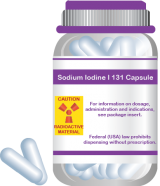Radionuclide Basics: Iodine
Iodine (chemical symbol I) is a chemical element. There are 37 known isotopesA form of an element that has the same number of protons but a different number of neutrons in the nucleus, giving it a different atomic mass. For example, uranium has thirty-seven different isotopes, including uranium-235 and uranium-238. of iodine, and only one is not radioactive (Iodine-127). Most radioactive forms of iodine are produced as a byproduct of a fissionThe splitting of an atomic nucleus into at least two other nuclei with the release of a relatively large amount of energy. Fissioning that occurs without any outside cause is called "spontaneous fission." reaction from either nuclear weapons testing or nuclear power plants. Some forms of radioactive iodine are manufactured for use in medicine. Iodine-129 and I-131 are the most commonly used radioisotopes and will have the greatest impact on the environment if released.
Iodine in the Environment
All 37 isotopes of iodine chemically interact with the environment in the same manner. Iodine can change directly from a solid into a gas, skipping the liquid phase, in a process called sublimation. Iodine dissolves easily in water or alcohol. Iodine readily combines with other elements and does not stay in its pure form once released into the environment.
Radioactive iodine can disperse rapidly in air and water. In soil, however, it combines easily with organic materials and moves more slowly through the environment.
If released, I-129 will remain in the environment for millions of years. Iodine-131’s short half-life of 8 days means that it will decay away completely in a matter of months.
Most I-129 in the environment came from nuclear weapons testing. Atmospheric testing in the 1950s and 60s released radioactive iodine to the atmosphere. Iodine-129 has dispersed around the world, and is now found at very low levels in the environment.
Iodine-131 in falloutRadioactive material in the air from a nuclear explosion that will cool into dust-like particles and fall to the ground. from nuclear weapons or reactor accidents can occur in particle form, which can be ingested in food or water.

Iodine Sources
I-131 is often used to treat thyroid cancer. In medicine, I-131 is supplied in capsules or liquid form for patients to swallow.
Learn about I-131 used in nuclear medicine.
Iodine and Health
External exposure to large amounts of iodine can cause burns to the eyes and skin. Internal exposure can affect the thyroid gland, a small organ located in the neck near the Adam’s apple. The thyroid gland uses iodine to produce thyroid hormones and cannot distinguish between radioactive iodine and stable (nonradioactive) iodine. If iodine were released into the atmosphere, people could ingest it in food products or water, or breathe it in.
In addition, if dairy animals consume grass contaminated with iodine, the radioactive iodine will be incorporated into their milk. Consequently, people can receive internal exposure from drinking the milk or eating dairy products made from contaminated milk. Once inside the body, radioactive iodine will be absorbed by the thyroid gland, potentially increasing the risk for thyroid cancer or other thyroid problems.
A precaution against thyroid exposure in a radiation emergency is to take Potassium Iodide (KI). Learn more about the use of Potassium Iodide (KI) in a radiation emergency.
